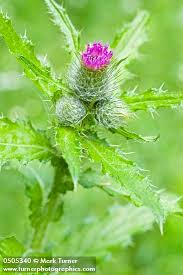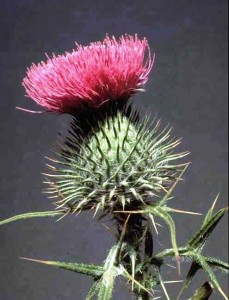from Kate Yturri, Judy Winer and Gwen Stamm
REPRINT FROM OCTOBER 3, 2013
Thistles are common, recognizable weeds in the San Juan Islands, yet there are several thistles that are native to the US, one of which is located in the county.
Our local native is known as Indian, short-style or clustered thistle (Cirsium brevistylum) and can be confused with bull thistle (C. vulgare). Both are up to 6 or more feet tall but the native, short-style thistle lacks spiny wings on the upper stems. It can also be distinguished from bull thistle by its hairy stem, and less deeply cut leaves that are arranged more symmetrically on the stem. Indian thistle’s stem is usually single and coated with hairs and webby fibers giving it a softer appearance. If you try to pull out a mature Indian thistle, its stem and leaves are relatively soft to the touch, whereas bull thistle is quite painful due to its spines. Thick leather gloves may be needed. It is more shade tolerant than bull thistle and provides food for native butterflies and birds.
In contrast to the native thistle, bull and Canada are noxious and should be controlled. Bull thistle delays reforestation by reducing the growth of tree seedlings in replanted clear cuts. Bull and Canada thistle reduce crop yield by competing for light, moisture and nutrients. They also threaten natural areas by competing with and displacing native plants. They prefer sunny, open spaces and can tolerate many different soil conditions, and are typically found in disturbed areas such as roadsides, trails, logged areas, vacant land, pastures and cultivated land. Overgrazed pastures are especially susceptible to bull thistle, since cattle tend to avoid it, forming large, dense stands that interfere with grazing. Both are widespread and are designated Class ‘C’ noxious weeds. Their removal is encouraged but not required in San Juan County.
Bull thistle, like Canada thistle, is a broadleaf, herbaceous plant. It is a biennial, which in its first year is a rosette of deeply lobed and prickly leaves. After winter, it bolts up to 6 feet tall or more and can become multi-stemmed. Leaves are alternate on branching and spiny-winged stems. The flowers are deep pink to purple and large, up to 1-2 inches wide, appearing singly on the ends of branches. The bases of the flowers are covered with spines, which help to distinguish them from the smaller spine-less Canada thistle flowers.
Whereas the biennial bull thistle spreads only by seed, Canada thistle (C. arvense), is an aggressive perennial weed that spreads by seed, root and rhizome. It has an extensive horizontal root system and new plants can grow from shoots that arise from the prolific root system. As with most perennials, the plants’ above-ground vegetation dies back to the ground in winter, but the root system beneath continues to grow, allowing plants to return in the spring.
Canada thistle can reach 4-5 feet in height, though female stems can reach up to 8’ tall according to Arthur Lee Jacobson, Wild Plants of Greater Seattle. Its alternate leaves, often hairy underneath, are typically elongated and variously toothed or lobed with spines on the margins and at the tips. The stems are erect and branching with small, ¾-inch purple-pink or rarely white flowers in clusters at the top. Flowering occurs from June to September in both species.
Control of these two types of thistle is not the same, but prevention is the most important measure for either species.
Since bull thistle reproduces by seed, removal of plants before flowering may prevent new infestations. Young plants can be dug with a shovel when in the rosette or seedling stage. The removal of 2-3 inches of the root is usually sufficient to kill the plant. Plants with tight flower buds can be mowed or cut just below the soil. Repeating this a month later should kill most of the plants. Flowering heads should be collected and destroyed or disposed of in plastic bags to keep them from forming viable seed. Over time, close cutting before flowering or at least twice a season will prevent seed production and reduce the population. Rototilling or hoeing will also effectively eliminate plants.
Goats and sheep both have been used for grazing management of bull thistle. Even horses will help by picking out the nectar-rich flowers and eating them before they go to seed.
Control of Canada thistle is more difficult than control of bull thistle. Manual digging, rototilling and hoeing are not recommended to control Canada thistle, as breaking up roots usually produces new plants. Since most of the plant is underground, strategies to starve this biomass are most likely to be successful. Mowing or cutting the thistles at their tight bud stage when nutrient reserves are lowest can be effective. Repeating this process every 21 days with each successive bud growth will eventually starve the plant, though it will be necessary to continue this practice through the growing months for 2-3 years to eradicate the plants. Inorganic mulches such as plastic and weed barrier fabrics may also be effective.
For herbicide recommendations contact the Noxious Weed Control Program at 376-3499.
**If you are reading theOrcasonian for free, thank your fellow islanders. If you would like to support theOrcasonian CLICK HERE to set your modestly-priced, voluntary subscription. Otherwise, no worries; we’re happy to share with you.**









